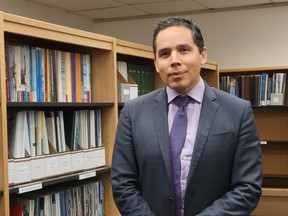National Indigenous leaders snubbed the recent premiers meeting over the inclusion of organizations with questionable legitimacy.
Author of the article:
Doug Cuthand • Saskatoon StarPhoenix
Published Jul 15, 2023 • Last updated 18 hours ago • 3 minute read
 Prime Minister Justin Trudeau talks with Natan Obed, president of the Inuit Tapiriit Kanatami as they participate in the Inuit-Crown Partnership Committee Leaders Meeting in Ottawa on Thursday, March 29, 2018. Photo by Sean Kilpatrick /THE CANADIAN PRESS
Prime Minister Justin Trudeau talks with Natan Obed, president of the Inuit Tapiriit Kanatami as they participate in the Inuit-Crown Partnership Committee Leaders Meeting in Ottawa on Thursday, March 29, 2018. Photo by Sean Kilpatrick /THE CANADIAN PRESS
This week the premiers’ annual meeting in Manitoba was supposed to include the national leaders representing the Inuit, First Nations and Metis, but the Inuit Tapirit Kanatami (ITK) declined, and the Metis National Council and the Assembly of First Nations sent regional representatives only.
Advertisement 2
This advertisement has not loaded yet, but your article continues below.
THIS CONTENT IS RESERVED FOR SUBSCRIBERS ONLY
Subscribe now to read the latest news in your city and across Canada.
Unlimited online access to articles from across Canada with one account. Get exclusive access to the Saskatoon StarPhoenix ePaper, an electronic replica of the print edition that you can share, download and comment on. Enjoy insights and behind-the-scenes analysis from our award-winning journalists. Support local journalists and the next generation of journalists. Daily puzzles including the New York Times Crossword.
SUBSCRIBE TO UNLOCK MORE ARTICLES
Subscribe now to read the latest news in your city and across Canada.
Unlimited online access to articles from across Canada with one account. Get exclusive access to the Saskatoon StarPhoenix ePaper, an electronic replica of the print edition that you can share, download and comment on. Enjoy insights and behind-the-scenes analysis from our award-winning journalists. Support local journalists and the next generation of journalists. Daily puzzles including the New York Times Crossword.
REGISTER TO UNLOCK MORE ARTICLES
Create an account or sign in to continue with your reading experience.
Access articles from across Canada with one account. Share your thoughts and join the conversation in the comments. Enjoy additional articles per month. Get email updates from your favourite authors.
So, what is behind this slight to the premiers? It comes from Manitoba Premier Heather Stephanson inviting the Congress of Aboriginal Peoples and the Native Women’s Association of Canada.
Article content
According to Natan Obed, the head of the Inuit Tapirit Kanatami, the two organizations don’t represent Indigenous nations as do the other three national bodies.
Most of the membership of CAP and NWAC are already represented by the three national organizations and a third party only dilutes and confuses things. This has been an ongoing issue for some time, and I applaud Natan Obed for pointing it out.
 Inuit Tapiriit Kanatami president Natan Obed. jpg
Inuit Tapiriit Kanatami president Natan Obed. jpg
CAP claims that it represents all the Indigenous people that don’t live on reserves, which is totally false. The provincial bodies such as the Federation of Sovereign Indigenous Nations have long since held to the position that the chiefs and councils represent all their people whether they live on or off the reserve.
We deliver the local news you need in these turbulent times on weekdays at 3 p.m.
By clicking on the sign up button you consent to receive the above newsletter from Postmedia Network Inc. You may unsubscribe any time by clicking on the unsubscribe link at the bottom of our emails or any newsletter. Postmedia Network Inc. | 365 Bloor Street East, Toronto, Ontario, M4W 3L4 | 416-383-2300
Article content
This advertisement has not loaded yet, but your article continues below.
Article content
This has been upheld by the Supreme Court, which ruled that First Nations people have a right to vote in their band elections if they are resident off reserve. This means we have representation through our chief and council and don’t need another body speaking for us.
Bill C-31, which was also the product of a Supreme Court decision, reinstated those individuals and their descendants that lost their band membership through marriage to a non-Indigenous person. This reduced CAP’s membership enormously.
Further, the tribal councils are extending their programming to include urban Indigenous people who need assistance. CAP has no comparable infrastructure and doesn’t have active programming for off-reserve Indigenous people.
This advertisement has not loaded yet, but your article continues below.
Article content
And further, through the vehicle of Treaty Land Entitlement, more and more first Nations are acquiring land in urban areas employing their people with plans for housing in the future. Clearly, our leaders are representing their people who live off reserve.
CAP is using an old colonial policy from the Department of Indigenous Affairs which stated that once an individual leaves the reserve they are no longer the responsibility of the department. Both CAP and the department are using the very narrow definition that Indigenous people fail to exist once they leave the reserve.
CAP claims to speak for all off-reserve indigenous people and in the process poaches their membership and legitimacy from the elected First Nations leaders.
This advertisement has not loaded yet, but your article continues below.
Article content
When half the First Nations population lives off the reserve, we are looking at close to 90,000 people right here in Saskatchewan. In fact, most of our people look to their chief and council for leadership and are unaware that CAP is claiming them.
This has been pointed out to the media and the politicians repeatedly, but they fail to grasp the seriousness of the situation. Governments use CAP to drive a wedge between the Metis and Indigenous people and muddy the waters.
CAP began its life as the Native Council of Canada, but once the Metis and First Nations developed their national organizations it languished in obscurity. It wasn’t until the constitutional talks got underway that they were given standing and had a voice at the table.
This advertisement has not loaded yet, but your article continues below.
Article content
But they were always on the fringe and their role seemed to be to confuse issues rather than solve anything. When he was head of CAP Patrick Brazeau used to snipe and attack the Assembly of First Nations much to the delight of the Harper government. His reward was to be made a member of the Canadian Senate.
This charade has gone on too long and CAP must redefine its membership and mandate. I agree that there is need for representation for Indigenous people that have lost land or have become unrecognized as First Nations.
But to keep pushing the equivalent of the big lie is unacceptable. They are simply competing with the legitimate organizations for resources and confusing the Metis and Indigenous political landscape.
This advertisement has not loaded yet, but your article continues below.
Article content
Divide and conquer is how the British acquired their empire. Canada continues with the tradition, this time turning indigenous people against each other.
Doug Cuthand is the Indigenous affairs columnist for the Saskatoon StarPhoenix and the Regina Leader-Post. He is a member of the Little Pine First Nation.

Doug Cuthand: Indigenous education means more than graduation rates

Doug Cuthand: Some Indigenous cultures feature teasing as humour
The Saskatoon StarPhoenix has created an Afternoon Headlines newsletter that can be delivered daily to your inbox so you are up to date with the most vital news of the day. Click here to subscribe.
Article content
>>> Read full article>>>
Copyright for syndicated content belongs to the linked Source : Saskatoon StarPhoenix – https://thestarphoenix.com/opinion/columnists/doug-cuthand-canada-continues-tradition-of-dividing-indigenous-people






























